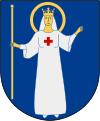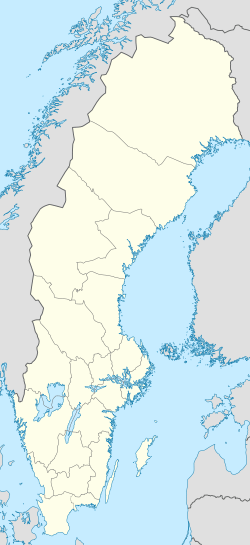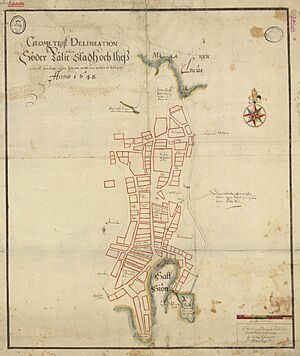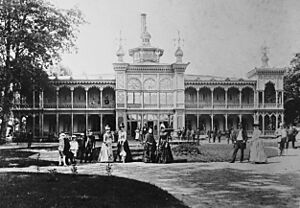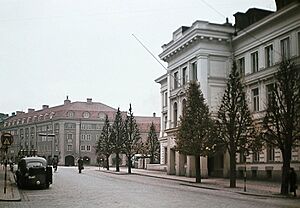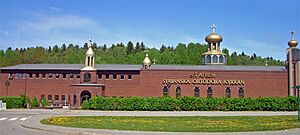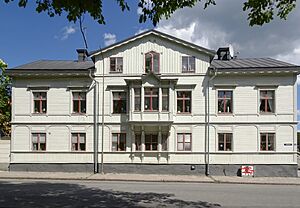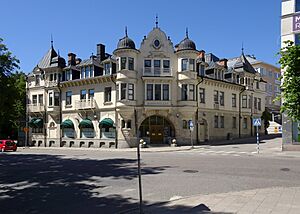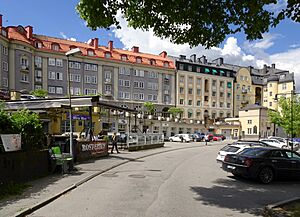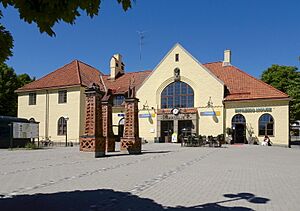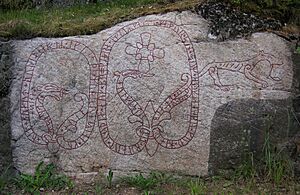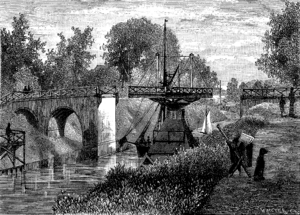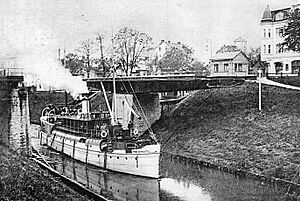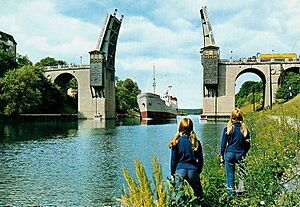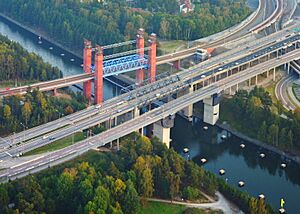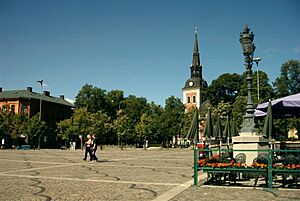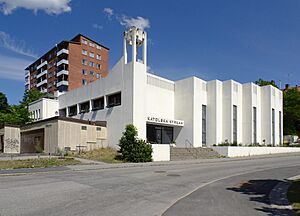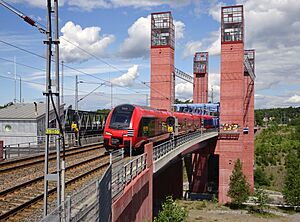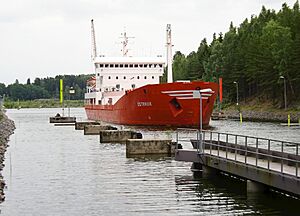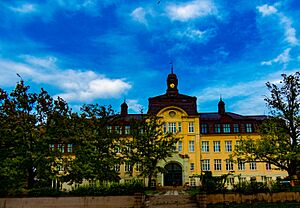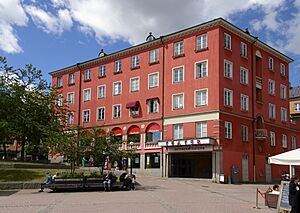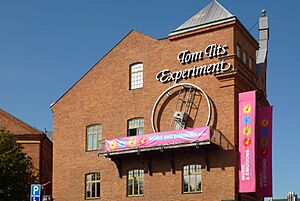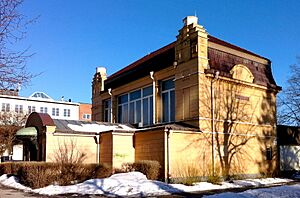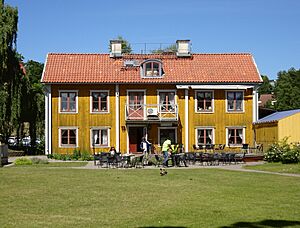Södertälje facts for kids
Quick facts for kids
Södertälje
|
||
|---|---|---|
|
City
|
||
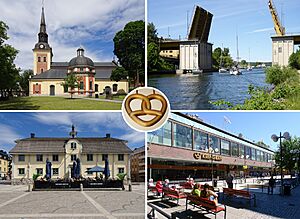
Sankta Ragnhild church, Mälarbron bridge, Old city hall, Storgatan street
|
||
|
||
| Nickname(s):
City of Pretzels
|
||
| Country | Sweden | |
| Province | Södermanland | |
| County | Stockholm County | |
| Municipality | Södertälje Municipality | |
| Founded | 1300s | |
| Area | ||
| • Total | 28.51 km2 (11.01 sq mi) | |
| Elevation | 23 m (75 ft) | |
| Population
(31 December 2020)
|
||
| • Total | 73,872 | |
| • Density | 2,591.1/km2 (6,710.9/sq mi) | |
| Time zone | UTC+1 (CET) | |
| • Summer (DST) | UTC+2 (CEST) | |
| Postal code |
151xx
|
|
| Area code(s) | (+46) 08 | |
| Website | www.sodertalje.se | |
Södertälje is a city in Södermanland and Stockholm County, Sweden. It is the main town of Södertälje Municipality. In 2017, about 72,704 people lived here. Södertälje is located where Mälaren lake connects to the Baltic Sea. This connection happens through a special lock in the Södertälje Canal. Since the year 2000, it has been the largest city fully within the Södermanland province.
Contents
Exploring Södertälje's Past
Södertälje has a long and interesting history. People first came to this area around 4000 BC, during the Stone Age. They started building settlements about 3000 BC. Around 1500 to 400 BC, the water passage between Lake Mälaren and the Baltic Sea became narrower. This meant boats had to be pulled over a sand ridge. This created jobs and helped trade grow.
Ansgar, a missionary, passed through Södertälje in 829. He was trying to bring Christianity to Sweden. Södertälje was first written about in 1070. It was mentioned in a description of a road between two other towns. Södertälje officially became a city in the 1300s.
A castle called Telge Hus was built in the 1300s. It was located on Slottsholmen island. This castle was used to manage the Telgehus county until 1527. Old digs show that the castle had a moat around it. You can still see parts of it today.
The city was first called Tälje. In 1622, the word "Söder" (meaning 'south') was added. This was to tell it apart from a new town called Norrtälje, which was founded to the north. The modern spelling, Södertälje, started being used in 1900.
The city's old symbol was St. Olof. In the 1600s, he was replaced by Ragnhild of Tälje. People say her special items were buried in Södertälje.
From the 1800s to the 1950s
Södertälje already had a port. But in the 1800s, it needed to be bigger for larger ships. The Södertälje Canal opened in 1819 after 13 years of building. Later, in 1860, trains started running between Södertälje and Stockholm. A main railway line opened in 1862, with a station in the city.
Around this time, Södertälje became a popular seaside resort for people from Stockholm. In 1849, the Södertälje Bathing Facilities opened. It had both cold and hot baths. Some old buildings from this time, like the Bath hotel and Villa Bellevue, are still there. This resort era lasted until 1945.
Södertälje is famous for its local pretzels, called Södertäljekringlor. This tradition is hundreds of years old. They were very popular during the resort era. Older women, called Kringelgummor (Pretzel ladies), often sold them. Tourists, especially at the train stations, loved buying them.
By the 1900s, Södertälje had over 8,000 people. Many big factories started here around this time. One important company was Vabis, which made railway cars and engines. In 1911, it joined with Scania to form Scania-Vabis. Today, it is known as Scania AB. Another big company was Astra, a chemical factory.
From 1950 to Today
In the 1950s, many parts of Södertälje's city center were considered old. The city grew, and new apartment buildings were built outside the center. So, the city council decided to rebuild the central areas. Many old wooden houses were taken down. Some were moved to the Torekällberget City Museum. However, many buildings from the 1600s to 1800s were saved.
In 1960, Södertälje was a small town with about 33,000 people. In the 1960s, the city changed a lot. Big companies like Scania-Vabis and Astra needed many workers. People came from other parts of Sweden to work. When there weren't enough workers from Sweden, people came from other countries. Many came from Finland, and also from Greece, Italy, and Yugoslavia.
In the 1970s, many Christian Assyrians/Syriacs settled in Södertälje. Most came from Tur Abdin, Turkey. Later, in the late 1990s, many Iraqis (mostly Assyrians) arrived. Now, Assyrians are the largest immigrant group in the city. About 39 percent of the city's people are first or second-generation immigrants.
Many of the city's modern attractions were built in the 1980s. A science museum called Tom Tits Experiment was built. The new public bath house Sydpoolen opened in 1987. It is now one of the most visited bath facilities in Sweden. In recent years, the canal has been made wider, and the railway has been improved.
Historical Population Growth
Here's how Södertälje's population has grown over the years:
- 1950: 25,715 people
- 1960: 33,721 people
- 1965: 44,362 people
- 1970: 57,494 people
- 1975: 58,408 people
- 1980: 58,711 people
- 1990: 58,097 people, 2,408 hectares
- 1995: 57,327 people, 2,456 hectares
- 2000: 59,342 people, 2,479 hectares
- 2005: 60,279 people, 2,529 hectares
- 2010: 64,619 people, 2,584 hectares
- 2015: 70,777 people, 2,797 hectares
- 2018: 73,872 people, 2,851 hectares
Södertälje's City Layout
In the 1600s, Södertälje had two big fires, in 1630 and 1650. After the 1650 fire, most important buildings were destroyed. The city was then rebuilt with a new, organized street plan. This plan still shapes many parts of the city center today. Most of the very old buildings are gone due to fires or being taken down.
Today, the main part of Södertälje is around Gågatan, which is a street just for walking. The old main square, Stortorget, was once the city's center. The city grew south because the Central Railway Station was built near the city park. Unlike many other cities, no railway tracks run through Södertälje's very center.
Södertälje used to have many wooden houses. This might be because it was not a major administrative center. The old wooden houses that were in the center have mostly been moved to Torekällberget, which is an open-air city museum. The first stone apartment building was built in 1865.
Södertälje's old City Hotel is on Saltsjötorget square. It was built for all the visitors when the city was a seaside resort. The square also has an old bank building. This building was used as the city hall from 1991 to 2008. The current city hall opened in 2008 and is also a cultural center.
The Central Railway Station is behind the City Hotel. It's special because it has two station buildings. The older one is made of brick. The yellow building was added later and is now used for tickets.
West of the station is Villa Bellevue. It was a famous building during Södertälje's resort days. It was built in 1871. The new city hall is next to it.
Most restaurants and bars are around Lake Maren. Marenplan square used to be Södertälje's most important port. Ships would bring goods there to sell. Boat traffic continued until 1963, when the Maren Bridge was built. The Sorbonne house, built in 1905, is where Lotsudden and Marenplan meet. It used to be a photography studio.
Just above Marenplan is Olof Palmes plats square. It was named after a former Prime Minister. An old bank building is on this square. Many buildings in Södertälje show Ragnhild of Tälje, the city's patron saint.
Most shops are on Gågatan (the Pedestrian street). This street has modern department stores built in the 1960s. The biggest ones are Kringlan, Luna, Åhléns, and Telgehuset. Kringlan is named after the famous local pretzel. An older bank building from 1901 is also on this street.
The hospital on Orionkullen was built in 1777–78. It was used as a hospital and later for education. Today, it is a cultural center. The main secondary school is east of the canal. Södertälje's current hospital is across the street from the secondary school. It is one of the county's six trauma centers.
The main square, Stortorget, was chosen to be halfway between the city's two ports. This made it easy for merchants to sell their goods. For hundreds of years, Stortorget was very important for lively markets. Today, Marenplan has become more central for trade. The old yellow wooden City Hall building on Stortorget opened in 1735. It now has art galleries and a café.
On the north side of Stortorget is Sankta Ragnhilds Kyrka (Church of Ragnhild of Tälje). It was built between the 1100s and 1300s. It is the main church in Södertälje. It has been rebuilt many times after fires and other events.
Nygatan street has mostly modern buildings. The Roxyhuset (Roxy house) was built in 1939. It used to have a cinema. Nygatan also has Södertälje's old Telegraph station. Below it is Torekällskolan school, the oldest school still in use, opened in 1869.
Holmfastvägen road starts in the city center. It connects to the Geneta area. This road was built in the 11th century. A large runic inscription called the Holmfast Inscriptions tells about its construction by a Viking named Holmfast.
Södertälje also has modern shopping areas outside the city center. Moraberg köpcentrum and Vasa handelsplats are two examples.
Bridges of Södertälje
For a long time, there was only one bridge connecting the east and west parts of Södertälje. It was a swing bridge near the old lock. It was built in 1910. Before that, people could also cross by rowing boats. These boats were often operated by women.
Today, there are three places to cross the Södertälje Canal by foot or car, plus two railway bridges. The northernmost is the Mälarbron bridge. It has had several bridges before it. The current Mälarbron opened in 1971.
The most central crossing is at the canal lock. It has two bridges: Marenbron over Lake Maren, and Slussbron over the canal. The Marenbron was first built in 1963. It was replaced by a bridge for walkers and cyclists.
The Saltsjöbron and E4-bron bridges are the southernmost crossings for cars and walkers. Saltsjöbron is a bascule bridge. E4-bron is a vertical-lift bridge for the E4 Motorway. It was built in the 1960s. Saltsjöbron was built in 2002 to help with traffic and as a backup.
Parallel to Saltsjöbron and E4-bron is a railway bridge for local and freight trains. It opened in 2010. It replaced an older bridge from 1921. The new bridge has wider spaces between its pillars, allowing the canal to be made even wider.
The Igelsta Bridge is the southernmost bridge in the city. It is the main route for long-distance trains over the canal. It is 2140 meters long and 48 meters high. This makes it Sweden's tallest and longest railway bridge. It opened in 1995. The Södertälje Syd railway station is located on this bridge.
Churches and Places of Worship
Södertälje has eight church buildings that belong to the Church of Sweden. The oldest and most important is Sankta Ragnhilds kyrka (Church of Ragnhild of Tälje). It is on the main square, Stortorget. Other churches include St. Michael's Church, Hovsjö Church, and Lina Church. Lina Church is known for its special design.
The main church in Östertälje is All Saints' Church. There is also Hagaberg's chapel, which was moved here in 1914. Brunnsäng Church is the newest church in the city.
Many other Christian groups have churches here too. The Catholic Church in Sweden has Sankt Ansgar's church. The Syriac Orthodox Church has five churches in Södertälje. There are also services in Finnish for the Sweden Finns community.
Getting Around Södertälje
Roads for Travel
The E4 and E20 Motorways split in Södertälje. Other important roads pass through the city, connecting it to towns like Trosa and Nynäshamn. Buses run regularly to these towns and to Stockholm.
Train Connections
Södertälje is a big railway hub in Sweden. Many train lines go through or to the city. You can find international trains to cities like Oslo and Copenhagen. There are also local, regional, and national train services.
Södertälje has four train stations:
- Södertälje Centrum (the central station)
- Södertälje Syd
- Södertälje Hamn
- Östertälje
It was tricky to build good train connections because the city is divided by a canal. The first railway station in Södertälje was called Södertelge Öfre. The central station was called Södertelge nedre. Over time, the names changed.
In 1994, the Igelsta Bridge opened. It is built high above the canal. Södertälje Syd railway station is on this bridge. It is the city's main station for long-distance trains. The old railway lines below the bridge are used by commuter trains.
Today, Södertälje is a key railway point. You can travel to Sweden's three biggest cities (Stockholm, Gothenburg, and Malmö) without changing trains.
Waterways and the Port
The first canal through Södertälje was built between 1806 and 1819. The canal has been made bigger and wider many times. Between 2016 and 2020, it was expanded again. Now, it can handle very large ships.
More than 40 boats pass through the Södertälje canal every day. They carry over 5 million tons of goods each year. Most of these goods go into Lake Mälaren. Things like coal, cement, and iron are transported. The port of Södertälje also moves goods from trains to trucks and ships.
The port has four main areas: Sydhamnen, Oljehamnen, Igelsta, and Uthamnen. Sydhamnen handles containers and cars. Södertälje's port is important for importing cars into Sweden. About 80,000 cars are handled here each year.
City Buses
Södertälje has about fifteen city bus lines. The Central Railway Station is the main bus hub. There are also special buses for seniors and people with disabilities. Night buses run all night, every day. The city has two circular bus routes, one on each side of the canal.
Södertälje's Economy

Södertälje is famous for two big companies: Astra Zeneca and Scania. The city has over 4,000 businesses in total. Most of these are small businesses with five or fewer employees.
Major Companies
Astra was started in 1913 by a pharmacist. It grew quickly, partly because of the need for medicine during World War I. In 1999, Astra joined with a British company called Zeneca. They formed the pharmaceutical group Astra Zeneca. The company's pill factory in Södertälje is the biggest in the world. It employs over 3,200 people.
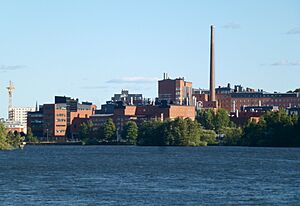
Vabis started in 1891. It made railway cars, engines, and trucks. In 1911, it merged with Scania to become Scania-Vabis. Today, the company is known as Scania AB. Its main office is still in Södertälje. Scania employs over 9,000 people in Södertälje, making it the city's largest employer.
Shopping in Södertälje
Most shopping is in the city center, especially on Storgatan and Järnagatan streets. The Kringlan department store opened in 1965. Its name, Kringlan (meaning The Pretzel), refers to Södertälje's long tradition of selling pretzels. Other big stores include Luna and Telgehuset. You can also find larger shops outside the city center in areas like Moraberg and Vasa Handelsplats.
Learning in Södertälje
KTH Royal Institute of Technology has a campus in Södertälje. Here, students can study subjects like Mechanical engineering and Logistics. They can earn a Master's degree. This education is done with the help of Scania and AstraZeneca. In 2018, KTH moved to a new campus called Södertälje Science Park. It has 1,200 students and researchers.
Campus Telge is another learning center. It offers different university courses and programs. Students can study here until they graduate.
Hagabergs folkhögskola is a folk high school that started in 1910. It is run by the Swedish Evangelical Mission. About 250 students study there. The school focuses on Christian theology.
In 2017, Södertälje had 13 secondary schools. Five were public schools, and eight were charter schools.
Södertälje's Culture and Fun
Södertälje's main theatre is Oktoberteatern at Marenplan. It puts on many new shows each year. It opened in 1928 as a cinema. Södertälje also has Sweden's only professional Finnish-language theatre group, Teatteri Kipinä.
The Cultural Centre in Ytterjärna is a popular place. It has a theatre, café, and meeting rooms. It opened in 1992. The building is known for its great sound quality, so many concerts are held there.
The City Hall has stages called Estrad and Trombon. They often host theatre, concerts, and films. A local tradition is the Täljerevyn, a funny show about the city and its politics.
Museums to Explore
Torekällberget open-air museum is one of the most popular places to visit. It's also called Södertälje City Museum. It opened in 1929 when a famous windmill and other buildings were moved there. Many old buildings from the city center were moved here in 1961. The museum has two parts: "the City" and "the Countryside." The city part has a main square with buildings from the 1700s–1800s. The countryside part shows what rural farms were like in the 1800s. You can also see farm animals there.
The Marcus Wallenberg-hallen (Marcus Wallenberg Hall) is a vehicle museum. It's next to the Scania AB headquarters. The museum has old vehicles, like Sweden's first mass-produced car from 1903. It also has old railway cars.
Södertälje is home to a large science museum called Tom Tits Experiment. It's named after a French writer. It started as a temporary show but became so popular that it became a permanent museum. It is the biggest Science center in Sweden. It has four floors and a park with over 400 science experiments. About 190,000 people visited in 2018.
Saltskog gård (Saltskog manor) was once the home of a businessman named Carl Fredrik Liljevalch. Today, it is a museum. The farm dates back to the 1500s. Liljevalch bought it in 1881. He wanted it to be a perfect example of farming. He also made it a cultural center with art. The garden has unusual trees. The manor now hosts art shows, concerts, and lectures.
Biologiska Museet (The Museum of Biology) was given to the city by Carl Fredrik Liljevalch. It opened in 1913, making it the oldest museum in the city. The museum shows animals and birds from the Sörmland province in their natural settings. It has over 100 different species. The museum was renovated and reopened in 1983.
The world's oldest propeller-driven steamship with its original engine is S/S Ejdern. It was built in 1880. Since 1906, its home port has been Södertälje. Today, a group called The Museum Association S/S Ejdern owns it. Since 1976, they run museum routes around Södertälje. The ship can carry 90 people. It often travels to Adelsö and the Viking city Birka.
Wendela Hebbes hus (Wendela Hebbe's house) is a museum about Wendela Hebbe. She was Sweden's first professional female journalist. She worked for a newspaper and wrote fairy tales. Her yellow wooden house was moved to its current spot between the canal and Marenplan. It now has a restaurant and a museum section. It also hosts theatre and exhibitions.
Södertälje Konsthall (Södertälje Museum of Arts) shows different art exhibitions. It opened in 1968. In 2015, another art museum, Grafikens Hus, moved to Södertälje.
Libraries for Learning
Södertälje's city library moved to its current location in 1978. It also hosts lectures, courses, and theatre. The library has smaller branches in other towns like Hölö and Järna. Some of these are combined school and public libraries.
Sports in Södertälje

In basketball, Södertälje BBK (SBBK) is one of the best teams in Sweden. The male team, Södertalje KINGS, won the Swedish Championship in 2013, 2014, and 2015. The female team, Telge Basket, has also won many championships. SBBK has won a total of 132 Swedish Championships since 1968. Their home arena is Täljehallen.
The city is home to Södertälje SK, a famous ice hockey team. They play in Sweden's second-highest league, HockeyAllsvenskan. Their home arena is Scaniarinken. Assyriska FF and Syrianska FC are two successful football clubs. They play at the Södertälje Fotbollsarena.
The Södertälje Rugbyklubb was formed in 1968. The Södertälje Storm Rugby League club plays in the Swedish National Rugby League.
Södertälje has an indoor swimming arena called Sydpoolen. It is used for training and races.
Södertälje's Climate
Södertälje has four clear seasons. Summers are warm and sunny, with average daytime temperatures around 20–23°C (68–73°F). Sometimes it can get hotter than 25°C (77°F). Winters are cold, with temperatures usually between -3°C and 1°C (27–34°F). Spring and autumn are cooler.
The city gets about 640 mm (25 inches) of rain each year. Snow usually falls from December to March. The amount of snow can change a lot each winter.
| Climate data for Södertälje, 1991-2020 normals and extremes | |||||||||||||
|---|---|---|---|---|---|---|---|---|---|---|---|---|---|
| Month | Jan | Feb | Mar | Apr | May | Jun | Jul | Aug | Sep | Oct | Nov | Dec | Year |
| Record high °C (°F) | 11.1 (52.0) |
11.9 (53.4) |
18.3 (64.9) |
26.0 (78.8) |
28.5 (83.3) |
30.3 (86.5) |
32.4 (90.3) |
31.3 (88.3) |
26.3 (79.3) |
22.5 (72.5) |
15.6 (60.1) |
13.0 (55.4) |
32.4 (90.3) |
| Mean maximum °C (°F) | 7.0 (44.6) |
7.8 (46.0) |
13.0 (55.4) |
20.0 (68.0) |
24.5 (76.1) |
26.9 (80.4) |
28.9 (84.0) |
27.4 (81.3) |
22.2 (72.0) |
16.1 (61.0) |
11.0 (51.8) |
7.6 (45.7) |
29.5 (85.1) |
| Mean daily maximum °C (°F) | 0.9 (33.6) |
1.4 (34.5) |
5.1 (41.2) |
11.1 (52.0) |
16.7 (62.1) |
20.5 (68.9) |
23.2 (73.8) |
21.9 (71.4) |
16.7 (62.1) |
10.2 (50.4) |
5.3 (41.5) |
2.2 (36.0) |
11.3 (52.3) |
| Daily mean °C (°F) | −1.6 (29.1) |
−1.7 (28.9) |
1.1 (34.0) |
5.7 (42.3) |
10.8 (51.4) |
15.1 (59.2) |
17.9 (64.2) |
16.8 (62.2) |
12.2 (54.0) |
6.9 (44.4) |
3.0 (37.4) |
−0.1 (31.8) |
7.2 (45.0) |
| Mean daily minimum °C (°F) | −4.1 (24.6) |
−4.5 (23.9) |
−2.5 (27.5) |
0.9 (33.6) |
5.4 (41.7) |
10.0 (50.0) |
13.0 (55.4) |
12.2 (54.0) |
8.2 (46.8) |
3.9 (39.0) |
0.7 (33.3) |
−2.5 (27.5) |
3.4 (38.1) |
| Mean minimum °C (°F) | −14.7 (5.5) |
−14.3 (6.3) |
−11.3 (11.7) |
−5.4 (22.3) |
−0.9 (30.4) |
4.2 (39.6) |
8.1 (46.6) |
6.3 (43.3) |
1.1 (34.0) |
−4.1 (24.6) |
−7.0 (19.4) |
−12.2 (10.0) |
−17.3 (0.9) |
| Record low °C (°F) | −23.7 (−10.7) |
−23.6 (−10.5) |
−21.8 (−7.2) |
−9.6 (14.7) |
−4.8 (23.4) |
1.3 (34.3) |
6.2 (43.2) |
3.5 (38.3) |
−4.5 (23.9) |
−9.4 (15.1) |
−11.8 (10.8) |
−25.0 (−13.0) |
−25.0 (−13.0) |
| Source 1: SMHI Open Data | |||||||||||||
| Source 2: SMHI 1991-2020 normals | |||||||||||||
Famous People from Södertälje

Many well-known people have connections to Södertälje:
- Hasse Aro, a TV show host.
- Kennedy Bakircioglu, a professional football player.
- Nicklas Bergfors, an ice hockey player.
- Mats Berggren, a writer.
- Björn Borg, a famous tennis player who grew up here.
- Louay Chanko, a professional football player.
- Daniel Despotovic, a professional ice hockey player.
- Johan Edlund, a guitarist and singer.
- Jan Guillou, an author and journalist.
- Carl Hagelin, an ice hockey player.
- Harry Källström, a rally driver.
- Felix Michel Melki, a football player.
- Alexander Michel Melki, a football player.
- Patrik Nordin, a ski mountaineer and cross-country skier.
- Karin Rådström, a chief executive officer at Mercedes-Benz Trucks.
- Bengt Westerberg, a former political party leader.
- Erkan Zengin, a professional football player who grew up here.
See also
 In Spanish: Södertälje para niños
In Spanish: Södertälje para niños


